Posts Tagged ‘USHMM’
Tuesday, June 14th, 2011
by Carolyn Yeager
MSU Prof. Kenneth Waltzer has been promising his book The Rescue of Children and Youth in Buchenwald since 2007. Four years later, he’s being very quiet about it.
Here is a timeline of announcements about this work in progress, all taken from his Michigan State University website.
May 2005: Professor Waltzer presented a paper, “The Rescue of Children at Buchenwald: Behavior in a Grey Area,” at the Midwest Jewish Studies Scholars Colloquium, Cohn-Haddow Judaic Studies Program, Wayne State University, Detroit.
March 2007: Ken Waltzer will present a paper on “The Kovno Boys: Survival at Auschwitz, Buchenwald, and Mauthaussen,” at the 37th Annual Holocaust Scholars Conference in Cleveland, Ohio.
April 2007: Ken Waltzer presents on his book-in-progress, The Rescue of Children and Youth in Buchenwald, at James Madison College.
May 2008: MSU Professor Ken Waltzer gave the Monna and Otto Weinmann Lecture at the U.S. Holocaust Memorial Museum on the subject of his upcoming book on the rescue operation at Buchenwald that he said saved the lives of hundreds of children and youths.
April 2010: Kenneth Waltzer, professor of history and director of the Jewish studies program at Michigan State University, is currently completing a book about the rescue of children and youths at Buchenwald. [From the April 16, 2010 The Jewish Daily Forward]
The Elie Wiesel Problem
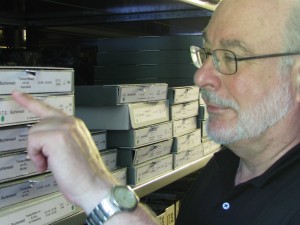 Prof. Waltzer has written and shown pictures of himself (right) doing research at Bad Arolson in Germany, seeking to discover details about the lives and families of the boys of Buchenwald. One of the boys that he may be having trouble with is Elie Wiesel. Waltzer has made a lot of claims and put himself on the line about Wiesel that, in this writer’s opinion, cannot be substantiated.
Prof. Waltzer has written and shown pictures of himself (right) doing research at Bad Arolson in Germany, seeking to discover details about the lives and families of the boys of Buchenwald. One of the boys that he may be having trouble with is Elie Wiesel. Waltzer has made a lot of claims and put himself on the line about Wiesel that, in this writer’s opinion, cannot be substantiated.
For example, last November Waltzer commented on this website to my article “Signatures Prove Lázár Wiesel is not Elie Wiesel” with the following:
Contrary to Carolyn Yeager’s wishful thinking, Eli Wiesel was indeed the Lazar Wiesel who was admitted to Buchenwald on January 26, 1945, who was subsequently shifted to block 66, and who was interviewed by military authorities before being permitted to leave Buchenwald to go with other Buchenwald orphans to France. Furthermore, there is not a shadow of a doubt about this, although the Buchenwald records do erroneously contain — on some pieces — the birth date of 1913 rather than 1928. A forthcoming paper resolves the “riddle of Lazar” and indicates that Miklos Gruner’s Stolen Identity is a set of false charges and attack on Wiesel without any foundation. ~~ by kenwaltzer on November 14, 2010 at 10:34 am
The birthdate on Lazar Wiesel’s records is erroneous—that’s his answer? He is going to “resolve” that? The “forthcoming paper” has not yet appeared 7 months later. His website pages have not been updated for awhile; in fact, they look downright dormant.
Here are the problems I think Waltzer is having, in addition to the birthdate problem:
- He has claimed for at least several years that a picture he has placed on his website of the boys walking out of the Buchenwald front gate shows Elie Wiesel “toward the left.” [See The Many Faces of Elie Wiesel] I say it is not Elie Wiesel, and I don’t know anyone but Waltzer who has identified this boy as Elie Wiesel. This picture is also shown on the USHMM website, and they make no mention of Elie Wiesel as one of the boys.
- In a Power Point presentation that is available on his website, Waltzer shows a group picture of the ‘religious boys’ out of those who went to France, that he says includes Elie Wiesel. I have studied this picture closely and do not see anyone who resembles Wiesel. If Waltzer knows that Elie Wiesel is in the picture, why doesn’t he identify him with an arrow?
Famous Buchenwald Liberation photo is another problem
As I pointed out in “The Many Faces of Elie Wiesel,” the pictures that Waltzer claims contain the face and person of Elie Wiesel do not resemble each other. The famous barracks photo which the New York Times declared to be Elie Wiesel as a 16-year old Buchenwald inmate—and is reproduced all over the world as Elie Wiesel—doesn’t look like the other 16-year old faces.
This writer suspects that Ken Waltzer is having difficulty convincingly incorporating Elie Wiesel into the story of the “boys of Buchenwald” and their rescue. He has been a friend and devotee of Wiesel for many years, they are both strongly associated with the U.S. Holocaust Memorial Museum, and Wiesel has been a part of his Buchenwald story from the beginning. But the real evidence for Elie Wiesel ever being an inmate at Buchenwald doesn’t exist. There are no photographs of Elie Wiesel at Buchenwald; there are no photos of Wiesel during his supposed one-year concentration camp period at all.
I think Waltzer believed this slipshod approach he employs would pass without comment, but he didn’t count on the appearance of Elie Wiesel Cons the World website. We are a real problem for Ken Waltzer!
10 Comments
Category Featured | Tags: Tags: Bad Arolson, Boys from Buchenwald, Elie Wiesel, Kenneth Waltzer, Michigan State University, New York Times, USHMM,
Social Networks: Facebook, Twitter, Google Bookmarks, del.icio.us, StumbleUpon, Digg, Reddit, Posterous.
Wednesday, September 22nd, 2010
By Carolyn Yeager
copyright 2010 Carolyn Yeager
Elie Wiesel has been identified – in some cases has identified himself – in these three photographs. A close examination brings up many questions.
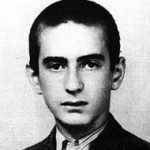
#1 – Elie in 1944, age 15 |
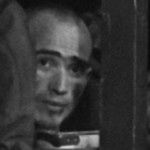
#2 – Elie on April 16, 1945, age 16½ |
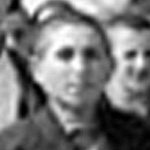
#3 – Elie on April 27, 1945, age 16½ |
Do any two of these pictures look like the same person? You might think that picture #2 or 3 has a vague resemblance to picture #1, but pictures 2 and 3 don’t in the least resemble each other. The man in picture #2 has a sharp aquiline nose, high cheekbones, full lips and looks quite a bit older than 16 years of age, while the round-headed lad in picture #3 has a wide face, short nose and low forehead. He looks younger than 16.
Picture #2 can be recognized as a close-up from the Famous Buchenwald Liberation Photo. [see page under The Evidence]. Weasel has maintained since the 1980’s that this is his face.
Picture #3 is taken from the photograph below. He is the boy in front of the tall boy in the left column of boys leaving Buchenwald, fourth from the front (the third boy in line is hidden from view). He’s been identified as Elie Wiesel by Prof. Kenneth Waltzer on his Michigan State University website. Wiesel has not denied it. The U.S. Holocaust Memorial Museum, however, doesn’t claim that Elie is in this picture (see USHMM below).
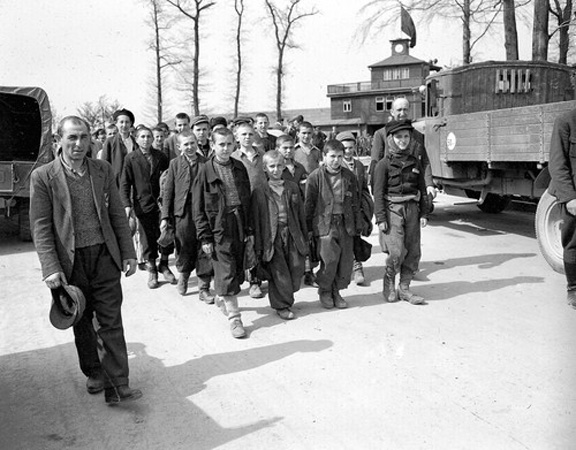
Above: Children march out of Buchenwald to a nearby American field hospital where they will receive medical care. Buchenwald, Germany, April 27, 1945. — Wide World Photo [Photo and caption from USHMM website]
Below: From Ken Waltzer’s MSU Newsroom Special Report page
Elie Wiesel at Buchenwald
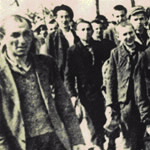
Elie Wiesel is fourth on the left, in front of the tall youth with beret.
Picture courtesy of the late Jack (Yakov) Werber, Great Neck, New York.
Waltzer writes on this same page:
In “Night,” Wiesel says that when he viewed himself in a mirror after liberation, he saw a corpse gazing back at him. But another picture [the one above] taken after liberation on April 17 [he has the date wrong], when the boys were led to the former SS barracks outside the camp, shows Wiesel marching out, fourth on the left, among a phalanx of youth moving together, heads held high, a group together guided by prisoners who had helped save them.
According to Waltzer, Elie Wiesel had a fast recovery to health, body mass and optimism, which Elie himself has never claimed. According to Buchenwald documents, these youths were not sent to France until July 16, 1945 (Fig. 12.4, 12.5),
Waltzer teaches German history and directs the Jewish Studies Program at MSU which includes courses on the Holocaust. He is writing a book about the orphan boys at Buchenwald titled “The Rescue of Children at Buchenwald.” Will Prof. Waltzer offer an explanation in his book for Elie Wiesel’s fit appearance in this photograph? He also accepts the man in the barracks photo as 16-year-old Wiesel. But then he has to, doesn’t he. How will he reconcile these two faces only eleven days apart?
USHMM
The USHMM features the picture shown below on its website—which Waltzer also refers to—and tells us that Elie Wiesel is among these boys without pointing out which one he is. Failing to find anyone who resembles Elie, I wrote to the USHMM asking them to identify him, but received no reply. [Update – because of a reader and also other pictures of Wiesel in France that surfaced later, I now believe Wiesel could be the darkish face in the 2nd to the last row, looking over the shoulder of the boy in a military-looking jacket and to the left of two boys in light-colored caps or berets. ]
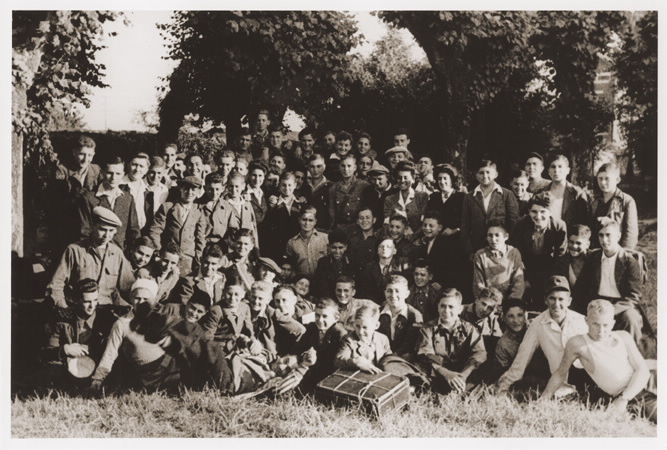 Group portrait of Jewish displaced youth at the OSE (Oeuvre de Secours aux Enfants) home for Orthodox Jewish children in Ambloy. Elie Wiesel is among those pictured. Ambloy, France, 1945. — USHMM, courtesy of Willy Fogel
Group portrait of Jewish displaced youth at the OSE (Oeuvre de Secours aux Enfants) home for Orthodox Jewish children in Ambloy. Elie Wiesel is among those pictured. Ambloy, France, 1945. — USHMM, courtesy of Willy Fogel
The U.S. Holocaust Museum dates this picture simply as 1945. It is definitely summer; the boys are dressed in their suits and “traveling clothes,” as if they had just arrived. A large suitcase is being held by a young boy seated in the front row. It fits in every respect the records for the Buchenwald transport that left Germany for France on July 16, 1945.
Wiesel is careful not to give dates for many important events in his memoir All Rivers Run to the Sea. In this book he writes in detail about his trip to France and his early years with the Oeuvre de Secours. Yet he gives not a single date, until he mentions that he first met his future mentor, Shushani, sometime in 1947.1 He writes of being active with the other Jewish youths – engaged in classes, choir practice, trips and flirtations – but strangely not a single photograph is available.
The next picture of Elie Wiesel I have found was taken in 1949. In fact, it is the first picture of him we can be sure of since the 15-year-old portrait of 1944, prior to deportation (picture #1). Why are there no pictures of Wiesel during all the years he was in the Jewish welfare system in France? We are told his sister Hilda, living in Paris, recognized him in 1945 in a photograph of OSE orphans that was published in a newspaper or magazine. What picture was that? [This question was finally answered. See http://www.eliewieseltattoo.com/another-photo-of-young-elie-wiesel-that-is-not-elie-wiesel/ The group photo above? There are no easy or available answers to these questions. It doesn’t take much imagination, however, to consider that it’s because there aren’t any that “fit” the story.
I find it more than ironic that on the page “Elie Wiesel Timeline and World Events, 1928-1951” there are three photographs and Elie Wiesel is not in any one of them!
The next picture I can find of Elie Wiesel was taken in 1949, on a ship heading for Israel. We see here the real Elie – long, narrow face, long nose (but not aquiline as in picture #2 above), large ears, high broad forehead, a slender build. He is 20 years old and a journalist, and has probably never looked better. [Maybe that’s why the picture was released.] We learn in his memoir that on May 14, 1948, when David Ben Gurion read out the Israel Declaration of Independence, Elie Wiesel had been working already for around six months for the Irgun Yiddish weekly newspaper Zion in Kamf (Zion in Struggle)– yes, Irgun, the terrorist gang. He remained with the Irgun until they closed their European offices in January 1949. He was then persuaded to go where the action was—to Israel. Helped by the Jewish Agency, and traveling with a few Irgun veterans, he boarded the ship Negba in May or June (uncertain), crossing to Haifa, Israel.2 This picture must have been taken during that trip.
 Elie Wiesel on a boat to Israel in 1949
Elie Wiesel on a boat to Israel in 1949
These are the faces of young Elie Wiesel during his “years of travail” that we have at our disposal—not much. I offer the opinion that too much is missing to accept unquestionably the story of his life, during these years 1944-1950, that has been manufactured for public consumption. Only two pictures: before Auschwitz and after his connection with the orphanage was concluded, are definitely him. The search continues.
Endnotes:
- Elie Wiesel, All Rivers Run to the Sea, Alfred Knopf, 1995, p 121.
- ibid, pg. 174-180
14 Comments
Category Featured | Tags: Tags: Buchenwald liberation, Irgun, Ken Waltzer, Oeuvre de Secours, Shushani/Chouchani, USHMM,
Social Networks: Facebook, Twitter, Google Bookmarks, del.icio.us, StumbleUpon, Digg, Reddit, Posterous.
Tuesday, August 24th, 2010
By Carolyn Yeager
Elie Wiesel stated under oath while giving testimony in the trial of Eric Hunt in San Francisco, California in July 2008 that the number A7713 was tattooed on his left arm. (see Where is the Tattoo? on this site)
Wiesel should have been asked to show his tattoo to the court at that time, but he wasn’t. This was a failure of the defense, for sure. But obviously, at that time, Mr. Hunt, the defendant, was not questioning whether Elie Wiesel had been an inmate of Auschwitz-Birkenau.
Since then, Mr. Hunt and others have uncovered video photography of Wiesel’s bare left arm from all angles, leaving no reasonable doubt that no tattoo is there. Backing up this conclusion is the fact that Wiesel has also famously refused to ever show his tattoo when requested to do so. For those who will retaliate that Wiesel may have had the tattoo removed, he said as late as March 25, 2010 that he still had the number A7713 on his arm. (see Where is the Tattoo?)
From this, the average man on the street would probably agree that Elie Wiesel has committed perjury (a criminal offense) if he does not indeed have the number tattooed on his arm. The law, according to http://www.lectlaw.com/def2/p032.htm, says:
When a person, having taken an oath before a competent tribunal, officer, or person, in any case in which a law of the U.S. authorizes an oath to be administered, that he will testify, declare, depose, or certify truly, or that any written testimony, declaration, deposition, or certificate by him subscribed, is true, willfully and contrary to such oath states or subscribes any material matter which he does not believe to be true; or in any declaration, certificate, verification, or statement under penalty of perjury, willfully subscribes as true any material matter which he does not believe to be true; (18 USC )
In order for a person to be found guilty of perjury the government must prove: the person testified under oath before [e.g., the grand jury]; at least one particular statement was false; and the person knew at the time the testimony was false.
However, in practice, the question of materiality is crucial. Perjury is defined at Criminal-law.freeadvice.com as:
the “willful and corrupt taking of a false oath in regard to a material matter in a judicial proceeding.” It is sometimes called “lying under oath;” that is, deliberately telling a lie in a courtroom proceeding after having taken an oath to tell the truth. It is important that the false statement be material to the case at hand—that it could affect the outcome of the case. It is not considered perjury, for example, to lie about your age, unless your age is a key factor in proving the case.
So the question becomes: Was the status of Elie Wiesel as a survivor of at least a seven-month incarceration at Auschwitz-Birkenau in 1944-45, in which case he would certainly have been tattooed on his left arm, as he states himself, material to the guilt or innocence of Eric Hunt in light of the charges that had been brought against him? Certainly, Eric Hunt, not long out of college at the time and who had been assigned to read Night in school, had come to doubt the truth of Wiesel’s assertions and descriptions in the book, and believed that if he could confront Wiesel alone, unguarded, he could convince him to tell the truth.
Does the suspicion that Wiesel necessarily lied in his book Night about what he saw and experienced at Auschwitz-Birkenau because he lied about the existence of a tattoo which he has always claimed as proof of his credentials as an Auschwitz survivor, exonerate Eric Hunt from some of the charges brought against him by the State of California? Is it material to the case? Perhaps not, but it does show cause for Eric Hunt’s desire to speak to Elie Wiesel in an unguarded moment, which was what he was attempting to do.
If Elie Wiesel cannot be legally found guilty of perjury because of questions of materiality, he will certainly be guilty of perjury in the eyes of the public if he does not produce the famous tattoo A-7713 on his arm—the sooner the better. We are waiting, Mr. Wiesel.
Watch a new, short video on the subject.
Addendum:
 ”Auschwitz survivor Sam Rosenzweig displays his identification tattoo.” From Wikipedia According to the information below, this man was in the “regular” series—numbers not preceeded with a letter of the alphabet. Note also that the tattoo is on the outside of the left forearm.
”Auschwitz survivor Sam Rosenzweig displays his identification tattoo.” From Wikipedia According to the information below, this man was in the “regular” series—numbers not preceeded with a letter of the alphabet. Note also that the tattoo is on the outside of the left forearm.
This is the best looking tattoo I could find on the Internet. If you want to have your faith in the Auschwitz Holocaust story badly shaken, google “Auschwitz tattoos” (or any variation thereof) – Images, and see what comes up. Frightening! Of the little that is there, most look like the numbers are way too big, and you find the same few people exhibiting their specimen.
However … George Rosenthal, Trenton, NJ, an Auschwitz Survivor, has written an “authoritative” account at Jewish Virtual Library based on “documents” obtained from The United States Holocaust Memorial Museum. (Sorry, no pictures here either, or on the USHMM website. Elie Wiesel was a major driving force in the creationof the USHMM; why didn’t he volunteer his tattoo to be pictured on their website as an example of what a genuine tattoo looks like? Why does the USHMM have no images of a tattoo?)
Mr. Rosenthal writes:
The sequence according to which serial numbers were issued evolved over time. The numbering scheme was divided into “regular,” AU, Z, EH, A, and B series’. The “regular” series consisted of a consecutive numerical series that was used, in the early phase of the Auschwitz concentration camp, to identify Poles, Jews, and most other prisoners (all male). This series was used from May 1940-January 1945, although the population that it identified evolved over time. Following the introduction of other categories of prisoners into the camp, the numbering scheme became more complex. The “AU” series denoted Soviet prisoners of war, while the “Z” series (with the “Z” standing for the German word for Gypsy, Zigeuner) designated the Romany. These identifying letters preceded the tattooed serial numbers after they were instituted. “EH” designated prisoners that had been sent for “reeducation” (Erziehungshäftlinge).
In May 1944, numbers in the “A” series and the “B” series were first issued to Jewish prisoners, beginning with the men on May 13th and the women on May 16th. The “A” series was to be completed with 20,000; however an error led to the women being numbered to 25,378 before the “B” series was begun. The intention was to work through the entire alphabet with 20,000 numbers being issued in each letter series. In each series, men and women had their own separate numerical series, ostensibly beginning with number 1.
According to this, since there was never a “C” series, the maximum number of prisoners that could have been tattooed after May 1944 was 45,378.
Under “Notes” at the bottom of the page, four books are listed, all by holocaust historians. Are these the “documents” referred to? It also says Source: Center for Holocaust and Genocide Studies at the very bottom of the page, as if referring to the entire page. This Center is located at the University of Minnesota. The affiliated faculty reveals mostly Jewish names.
I report all this because I’m looking for authoritative sources for the exact placement of the tattoos on the left arm, but one doesn’t find that answer even at the Auschwitz-Birkenau Memorial Museum. Why all the uncertainty? Could it be because so many pseudo-survivors have tattooed themselves in unusual ways and places, and the authorities don’t want to nullify their legitimacy?
23 Comments
Category Featured | Tags: Tags: Auschwitz tattoos, Auschwitz-Birkenau Museum, Eric Hunt, George Rosenthal, perjury, Sam Rosenzweig, USHMM, Wiesel's non-tattoo,
Social Networks: Facebook, Twitter, Google Bookmarks, del.icio.us, StumbleUpon, Digg, Reddit, Posterous.
 Prof. Waltzer has written and shown pictures of himself (right) doing research at Bad Arolson in Germany, seeking to discover details about the lives and families of the boys of Buchenwald. One of the boys that he may be having trouble with is Elie Wiesel. Waltzer has made a lot of claims and put himself on the line about Wiesel that, in this writer’s opinion, cannot be substantiated.
Prof. Waltzer has written and shown pictures of himself (right) doing research at Bad Arolson in Germany, seeking to discover details about the lives and families of the boys of Buchenwald. One of the boys that he may be having trouble with is Elie Wiesel. Waltzer has made a lot of claims and put himself on the line about Wiesel that, in this writer’s opinion, cannot be substantiated.








